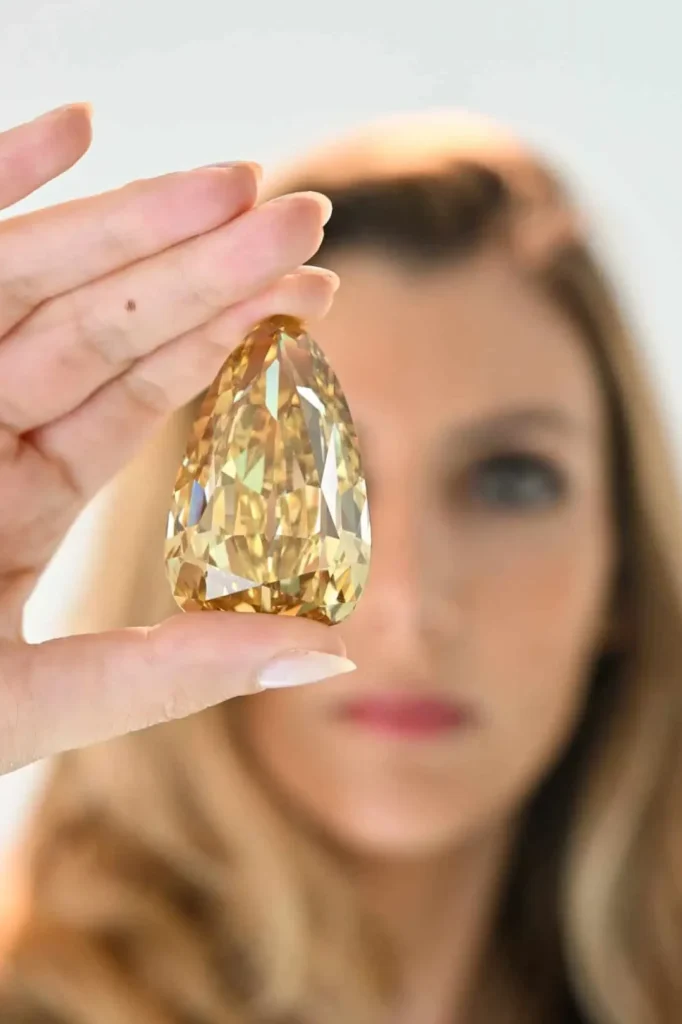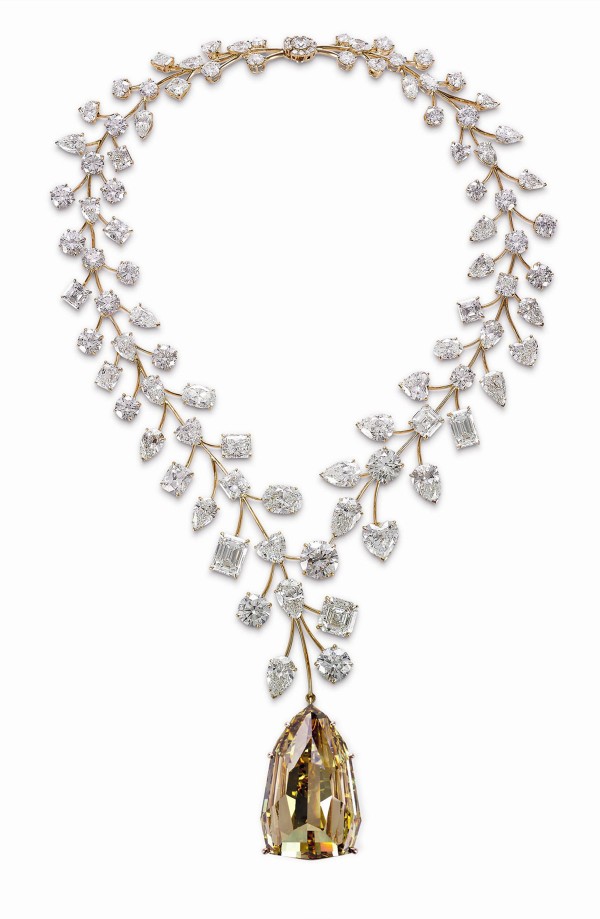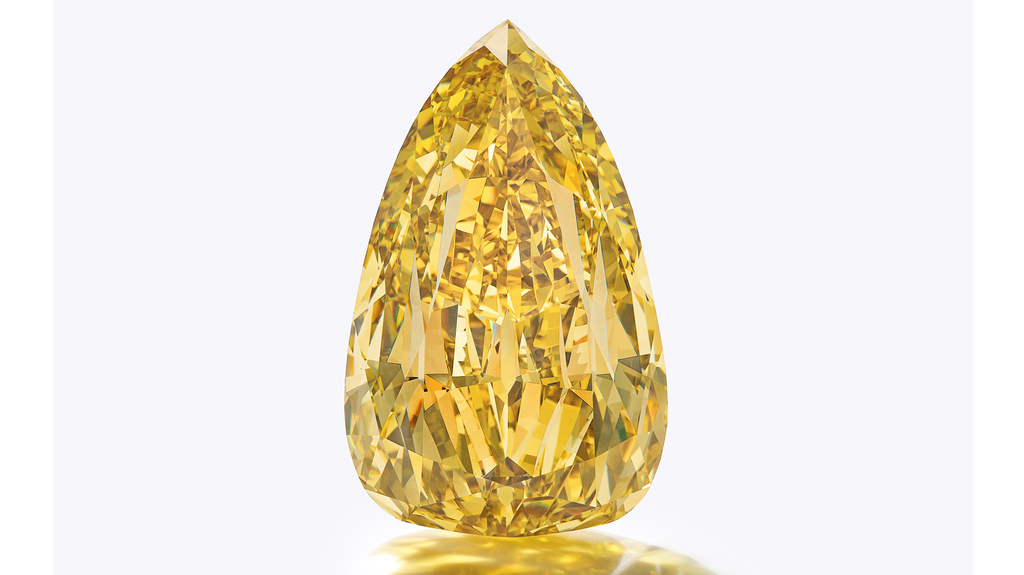The Incomparable Diamond usually described in superlatives – such as the World’s largest faceted Yellow Diamond; the World’s largest Internally Flawless Diamond; the World’s third largest faceted diamond after the 545.67-carat Golden Jubilee diamond and the 530.20 Cullinan I diamond; the diamond that entered the Guiness Book of World Records as part of the impressive L’Incomparable Diamond Necklace created by Mouawad Luxury Jewelry Company in 2013, in which the diamoind is set as a pendant to an 18k rose gold necklace, incorporating 637 carats of white diamonds – was announced on October 17, 2022, to have undegone a rebirth as the Golden Canary Diamond, after being re-cut from its original 407.5 carats shield-shape step-cut or triolette-cut to a 303.3-carat, Internally Flawless, fancy-deep brownish-yellow, pear modified brilliant-cut diamond.

It is said that the present owners of the diamond agreed to a recut of the Incomparable Diamond, based on a recommendation of the GIA to enhance its color and vibrancy, based on the advances in technology, computer modelling, and visual evaluation available today.
The Incomparable diamond was discovered in the early 1980s, in the town of Mbugi Mayi, in the Democratic Republic of Congo (former Zaire). This is the same area where subsequently in the year 1990, the 777-carat rough stone that yielded the exceptional quality Millennium Star diamond was discovered. In the rough state the diamond weighed 890 carats, making it the 4th largest gem-quality rough diamond to be discovered in the world.

The story of the accidental discovery of the diamond is quite interesting. A young girl was playing outside her uncle’s house, where rubble from a nearby diamond mine had been dumped. The rubble had originated from old mine dumps from the nearby MIBA Diamond Mine. Mine dumps consist of soil and rubble that have already been screened for diamonds or have been rejected during the recovery process as being too bulky to be worth scanning for diamonds. The girl picked up an unusual stone from the rubble, perhaps out of curiosity and after playing with it for sometime gave it to her uncle, instead of throwing it back to where it belonged. After close examination her uncle realized that it was an unusually large diamond, and after confirming the stone was indeed a rough diamond, he sold it to some local African diamond dealers. The local diamond dealers carried the rough stone to Kinshasa, the capital city of Zaire, and met a group of Lebanese diamond dealers operating in the capital city. The Lebanese having examined the rough stone and being convinced of it’s genuineness, purchased the rough stone from the African dealers for an undisclosed amount.

The Lebanese dealers carried the stone to Antwerp in Belgium, and sold it to a Senior Buyer of the De Beers Company, which was then examined by Sir Phillip Oppenheimer, a Director of De Beers and President of the Central Selling Organization, a body that controls much of the world diamond trade. Mr. Oppenheimer was impressed by the enormous size and the color of the rough stone, but however decided to sell the diamond to Donald Zale, Chairman of the Board of the Zale Corporation, the Dallas based jewelry store chain. Donald Zale purchased the diamond in partnership with two other prominent diamond dealers of New York, Marvin Samuels of the Premier Gem Corporation, and Louis Glick. The enormous rough diamond was finally unveiled to the world, on the important occasion of the 75th anniversary of the Zale Corporation, that fell in November 1984.
Thereafter, in 1984, the rare and enormous rough diamond, was put on display at the Natural History Museum of the Smithsonian Institution, in Washington DC. alongside some of the world’s most notable diamonds and became a global sensation.
Over the next four years the enormous rough diamond was cut into 15 pieces, one larger piece and 14 smaller stones. The largest piece, which was faceted and polished became the 407.48-carat, fancy brownish yellow diamond, with the highest clarity grade of internally flawless (IF), and was christened “The Incomparable Diamond.’ The cut of the diamond is described as a shield-shaped step cut. A new technical term coined by Mr. Marvin Samuels, a co-owner of the diamond, and head of the team of master-cutters who fashioned this unique diamond, describes the cut as a “triolette shape.” The dimensions of the stone was 53.90 x 35.19 x 28.18 mm.
After cutting and polishing, the Incomparable Diamond was put on display in many Museums, such as the American Museum of Natural History in New York City in 1997, the Museum National d’Histoire Naturelle in Paris in 2001 and later as part of The Nature of Diamonds Exhibition that toured the Royal Ontario Museum and the Houston Museum of Science in 2008.
The GIA issuing a monograph on the recutting of the Incomparable Diamond, states “The re-cut of the Incomparable to the current 303.10 carat pear modified brilliant is to look at the diamond as new; a re-creation bringing to bear the advances in technology, computer modeling and visual evaluation available today. Everything from the orientation of the stone to its shape and cutting style has been considered.”
Recutting the Incomparable Diamond to maximize the depth of its color, brighten its hue, and improve its shape, also lowered its weight by more than 100 carats. The 303.3-carat Golden Canary Diamond, is the largest internally flawless diamond ever graded by the Gemological Institute of America.
The newly reborn “Golden Canary Diamond” is a 303.3-carat, Internally Flawless, fancy-deep brownish-yellow, pear modified brilliant-cut diamond.
Sotheby’s Auction House announced on October 17, 2022, that the newly reborn “Golden Canary Diamond” the 303.3-carat, Internally Flawless, fancy-deep brownish-yellow, pear modified brilliant-cut diamond, will lead the December 7, New York Magnificent Jewels Sale, with an estimate in the region of US$15 million, but offered without a reserve and bidding starting from US$ 1/=.
Sotheby’s is expected to showcase the “Golden Canary Diamond” on a world tour prior to the auction, with stops in cities including Dubai, Taipei, Taiwan, Geneva and Hong Kong.
Commenting on the upcoming auction, Quig Bruning, Head of Jewelry for Sotheby’s America’s said, “We have had an exceptional year of presenting extraordinary coloured diamonds at our global jewellery auctions, as the demand and appetite for these rarities continues to grow. Just two weeks after the record-breaking sale of the Williamson Pink Star for $57.7 million, we are honoured to offer the largest polished diamond in present existence to appear at auction.”
“Steeped in history, The Golden Canary is one of the most exquisite diamonds to ever be discovered, not only for its sheer size and intensity in colour, but for its stunning beauty that is sure to captivate collectors around the world. Sotheby’s is privileged to help write the next chapter for this incomparable, reborn gem.”
